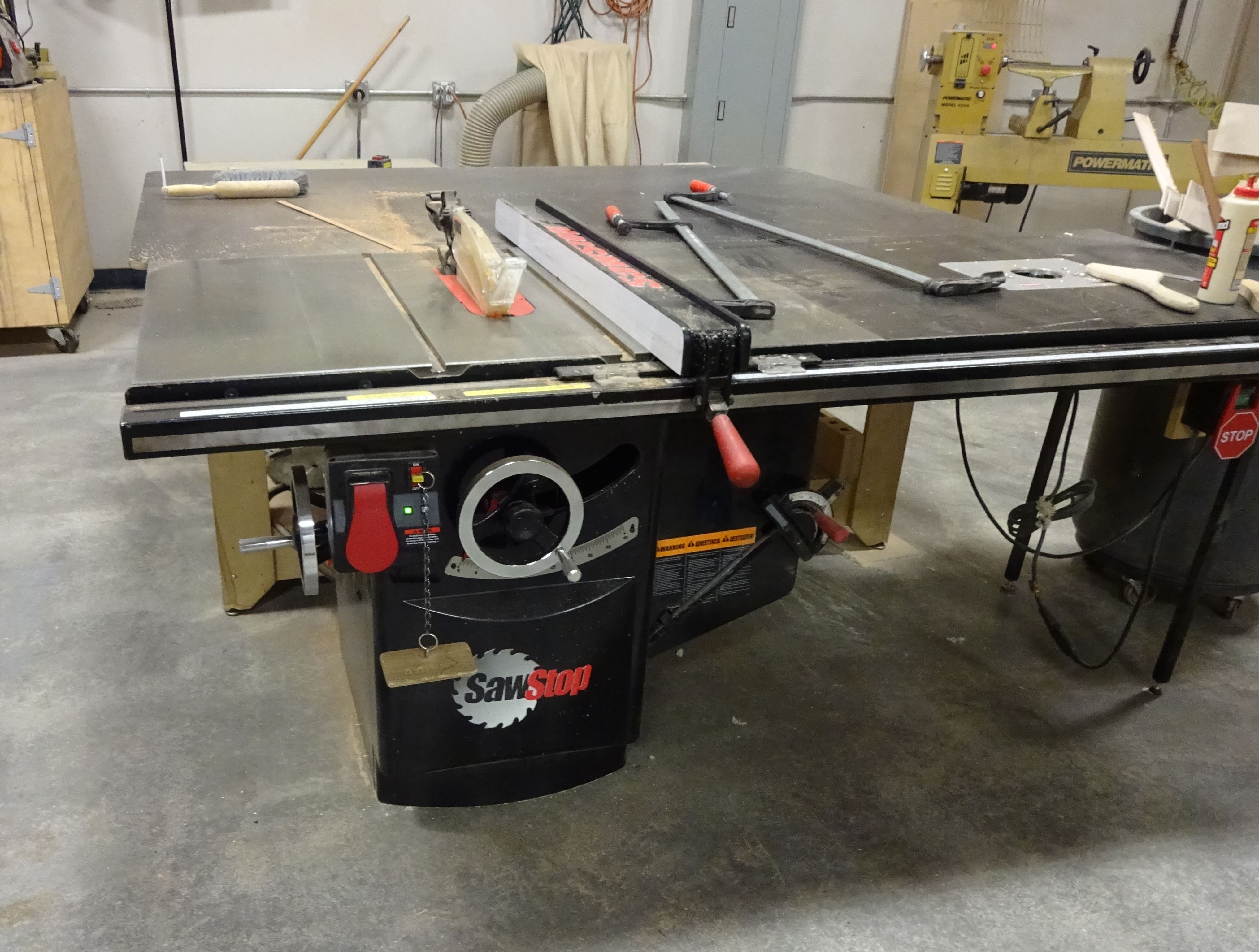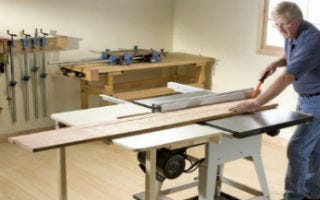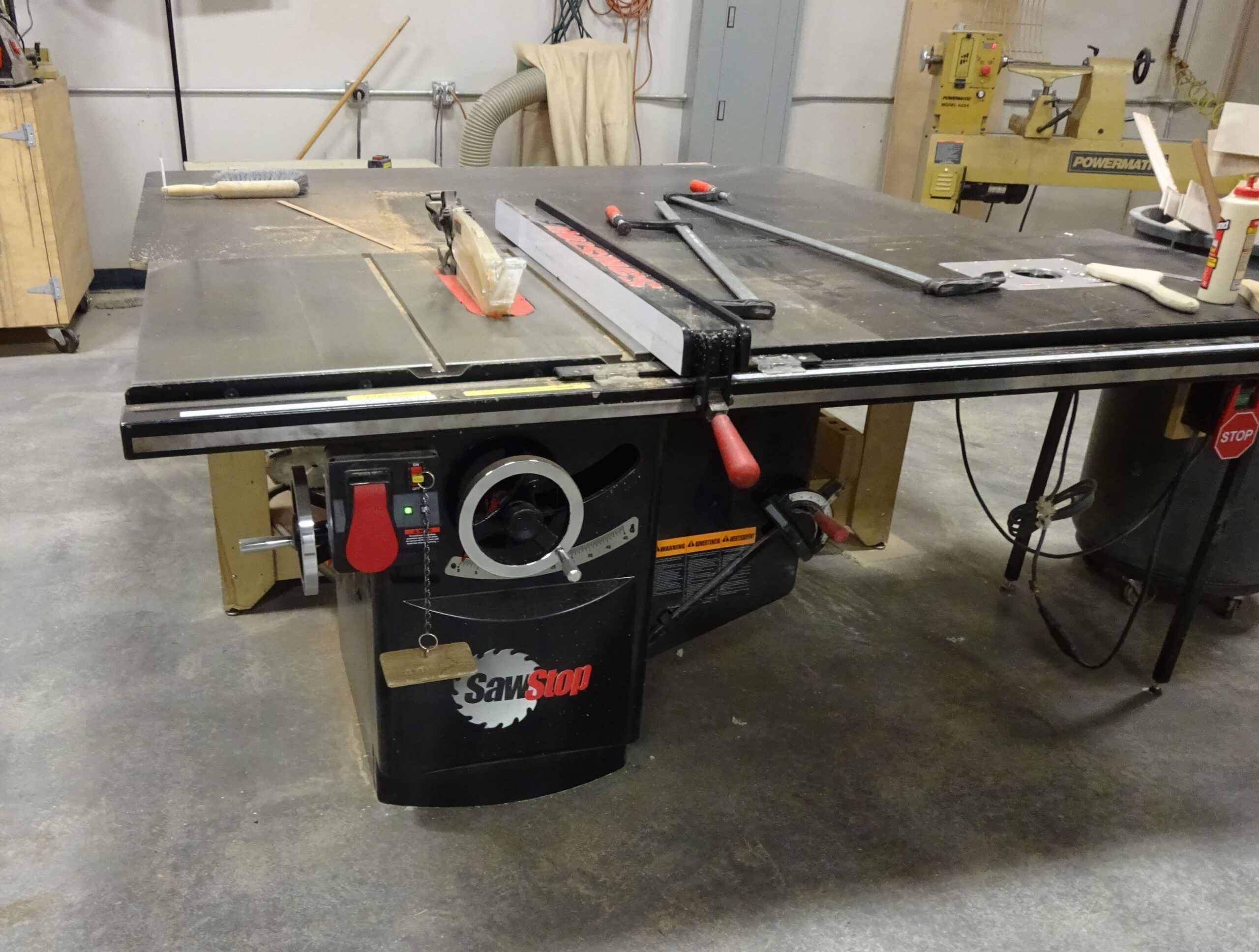What is a table saw in woodworking? If you’re curious about this powerful tool, you’ve come to the right place! In this guide, we’ll explore the ins and outs of table saws, from what they are to how they’re used, and everything in between. So, let’s dive in and discover the world of woodworking with table saws!
A table saw is a versatile woodworking tool that every woodworker dreams of having in their workshop. It’s like the superhero of cutting tools, with a flat surface and a circular blade that can slice through various types of wood with precision and ease. Whether you’re a beginner or an experienced woodworker, a table saw is an essential piece of equipment that can help you unleash your creativity and bring your woodworking projects to life.
But what makes a table saw so special? Well, imagine having a powerful machine that can make accurate and straight cuts like a pro. With a table saw, you can make rip cuts, crosscuts, miter cuts, and even dado cuts effortlessly. It’s like having a reliable assistant that takes care of the hard work while you focus on the creative aspects of your woodworking projects. So, whether you’re building furniture, cabinets, or intricate wooden crafts, a table saw is an invaluable tool that can help you achieve professional results.
Now that you have a grasp of what a table saw is in woodworking, let’s delve deeper into its features, functions, and safety precautions. Get ready to unlock the potential of this remarkable tool and take your woodworking skills to new heights!

What is a Table Saw in Woodworking?
Woodworking is a craft that requires precision, skill, and the right tools. One such tool that plays a crucial role in producing accurate cuts is the table saw. A table saw, also known as a sawbench, is a woodworking tool consisting of a circular saw blade mounted on an arbor, powered by an electric motor. It is typically used for cutting wood in a straight line, making it an essential tool for woodworkers and carpenters alike.
The Anatomy of a Table Saw
A table saw consists of several key components that work together to ensure precise and efficient cutting. The main elements of a table saw include:
- The Tabletop: This is the flat surface on which the wood is positioned for cutting. It provides stability and support during the cutting process.
- The Rip Fence: The rip fence acts as a guide, allowing the woodworker to make accurate cuts parallel to the edge of the wood. It can be adjusted to different distances from the blade.
- The Blade: The blade is the cutting tool of the table saw. It’s a circular saw blade with sharp teeth designed to cut through wood with precision.
- The Blade Guard: The blade guard is a safety feature that covers the blade during operation, protecting the user from potential accidents.
- The Miter Gauge: The miter gauge is a device that helps woodworkers achieve angled or beveled cuts. It can be adjusted to various angles for versatile cutting options.
- The Power Switch: The power switch allows the user to turn the saw on and off. It should always be easily accessible for safety reasons.
Understanding the different parts of a table saw is crucial for using it effectively and safely. Each component plays a vital role in ensuring accurate cuts and preventing accidents.
The Benefits of Using a Table Saw
Table saws offer several advantages that make them an invaluable tool for woodworkers. Here are some of the key benefits:
- Precision Cutting: With a table saw, woodworkers can achieve incredibly precise cuts, making it easier to create intricate designs and joinery.
- Efficiency: Table saws allow woodworkers to make straight cuts quickly and efficiently, saving time and effort in the workshop.
- Versatility: Table saws can be used for a wide range of woodworking tasks, including ripping, cross-cutting, dadoing, and beveling.
- Repeatable Cuts: The rip fence and miter gauge on a table saw enable woodworkers to make consistent and repeatable cuts, ensuring uniformity in their projects.
- Safety Features: Modern table saws come equipped with various safety features, such as blade guards, riving knives, and anti-kickback mechanisms, to help prevent accidents and keep users safe.
These benefits make the table saw an essential tool in any woodworking shop, helping woodworkers achieve precision and efficiency in their projects.
Table Saw vs. Other Woodworking Tools
While there are many tools available for woodworking, the table saw stands out for its unique capabilities and versatility. Here’s how it compares to other commonly used woodworking tools:
Table Saw vs. Circular Saw:
Table saws and circular saws both have circular blades, but they differ in terms of functionality. While a circular saw is handheld and primarily used for cutting large sheets of wood or making rough cuts, a table saw offers more precision and control. Table saws excel at making straight cuts and are ideal for smaller, more intricate woodworking projects.
Table Saw vs. Miter Saw:
Miter saws and table saws serve different purposes in the woodworking world. A miter saw is best suited for making crosscuts, miter cuts, and bevel cuts at various angles. On the other hand, a table saw is more versatile, capable of handling a wider range of cuts, including rip cuts, dado cuts, and angled cuts. Both tools have their place in a well-equipped woodworking shop.
Table Saw vs. Band Saw:
Band saws and table saws are both valuable tools in woodworking, but they have different cutting capabilities. Band saws are known for their ability to make curved cuts and intricate shapes, making them great for detailed work. Table saws, on the other hand, excel at making straight cuts and are better suited for tasks like ripping and cross-cutting. The choice between the two depends on the specific needs of the project.
The History of Table Saws
The table saw is a tool that has evolved over centuries to become the versatile and indispensable tool it is today. Its history can be traced back to ancient civilizations, where early versions of saws were used for various woodworking tasks. However, the concept of a table saw as we know it today began to take shape in the 18th century.
Early Development
The earliest evidence of a table saw can be found in ancient Egypt, where depictions of saws being used in carpentry work have been discovered. These early saws were operated by hand and lacked the advanced features we see in modern table saws.
Fast forward to the 18th century, and we see the emergence of the first mechanized table saws. French inventor Jacques de Vaucanson is often credited with creating one of the first power-driven table saws around 1760. This early version used a reciprocating blade driven by a foot pedal, which allowed for more efficient and precise cutting.
Industrial Revolution and Advancements
The industrial revolution brought significant advancements in table saw technology. In the mid-19th century, the introduction of steam-powered machines revolutionized the woodworking industry, including the development of more powerful table saws. These early steam-powered saws were still quite large and operated by multiple operators.
Throughout the late 19th and early 20th centuries, improvements in motor technology and the widespread adoption of electricity led to the development of the modern electric table saw. These saws featured more compact designs, safer operation, and increased cutting capabilities.
Modern-Day Table Saws
Today, table saws have become a staple in both professional woodworking shops and hobbyist workshops. Manufacturers continue to innovate and introduce new features, such as improved safety mechanisms, dust collection systems, and more precise cutting capabilities.
From its humble beginnings in ancient Egypt to the advanced tools we have today, the table saw has come a long way. It has transformed woodworking, making it easier, safer, and more precise for woodworkers around the world.
Choosing the Right Table Saw for Your Needs
When it comes to selecting a table saw, there are several factors to consider to ensure you choose the right tool for your woodworking needs. Here are some key points to keep in mind:
Types of Table Saws
There are several types of table saws available on the market, each with its own strengths and applications. The main types include:
- Benchtop Table Saws: These portable saws are lightweight and designed to be placed on a workbench or table. They are suitable for small projects and hobbyist use.
- Contractor Table Saws: Contractor table saws are larger and more powerful than benchtop saws. They are designed for on-site use and are ideal for contractors or woodworkers who need a portable option.
- Cabinet Table Saws: Cabinet table saws are heavy-duty machines with powerful motors and large cutting capacities. They are typically used in professional woodworking shops and offer the greatest accuracy and stability.
- Hybrid Table Saws: Hybrid table saws incorporate features from both contractor and cabinet saws, offering a balance between portability and power. They are a popular choice for serious hobbyists and small woodworking businesses.
Consider the type of projects you will be working on and the level of portability you require when selecting a table saw.
Motor Power and Blade Size
The motor power and blade size of a table saw determine its cutting capacity. For general woodworking tasks, a motor power of 1-2 horsepower (HP) is usually sufficient. However, if you plan to work with thicker or harder woods, a more powerful motor may be necessary.
Blade size is another important consideration. Common blade sizes for table saws range from 8 to 12 inches in diameter. A larger blade allows for deeper cuts, but it also requires a more powerful motor to drive it effectively.
Features and Accessories
Table saws can come with a variety of features and accessories that enhance their capabilities. Some common features to look for include:
- Riving Knife: A riving knife helps prevent kickback and ensures safer operation.
- Dust Collection System: A dust collection system helps keep your work area clean and free from potentially harmful sawdust.
- Extension Table: An extension table provides additional support for larger workpieces.
- Fence System: A high-quality fence system ensures accurate and straight cuts.
Consider your specific woodworking needs and prioritize the features that are most important to you.
Tips for Using a Table Saw Safely
While a table saw is a valuable tool, it can also be dangerous if not used properly. Here are some essential safety tips to keep in mind when using a table saw:
Wear Safety Gear
Always wear appropriate safety gear, including safety glasses, ear protection, and a dust mask. This will protect you from debris, noise, and potentially harmful dust particles.
Keep your Workspace Clean
Regularly clean your table saw and remove sawdust and debris from the table, blade, and other components. A clean workspace helps prevent accidents and ensures smooth operation.
Use Push Sticks and Featherboards
Push sticks and featherboards are essential tools for guiding wood through the table saw. They help keep your hands safe and maintain a consistent feed rate, reducing the risk of kickback.
Never Reach Over the Blade
Avoid reaching over the blade while it is spinning or attempting to remove debris or make adjustments. Always turn off the saw and let it come to a complete stop before making any changes or reaching into the cutting area.
Stay Focused and Avoid Distractions
When operating a table saw, maintain your focus on the task at hand. Avoid distractions that could compromise your safety and concentration.
Read the Manual
Before using a table saw, thoroughly read the manufacturer’s manual to familiarize yourself with the specific safety guidelines and operating procedures.
By following these safety tips and practicing caution, you can minimize the risk of accidents and injuries while using a table saw.
Mastering the Table Saw: Practice Makes Perfect
Using a table saw effectively requires practice and experience. Here are a few tips to help you master the art of table saw woodworking:
Start with Basic Cuts
Begin by practicing basic cuts, such as crosscuts and rip cuts, on scrap wood. Focus on maintaining accuracy and controlling the wood as it passes through the blade.
Learn to Use Jigs and Fixtures
Jigs and fixtures are specialized tools that assist with specific cuts or tasks. Explore different jigs and fixtures to expand your cutting capabilities and improve your woodworking skills.
Experiment with Different Blades
Different types of blades are designed for specific tasks. Experiment with different blade types, such as ripping blades, crosscut blades, and dado blades, to achieve different results and improve your understanding of their capabilities.
Seek Guidance and Learn from Experts
Consider taking woodworking classes or seeking guidance from experienced woodworkers. Learning from those with expertise can accelerate your learning and help you avoid common mistakes.
Practice Safety Precautions
Always prioritize safety and follow the recommended safety precautions when using a table saw. Develop good habits from the start to ensure safe and enjoyable woodworking experiences.
Remember, mastering the table saw takes time and practice. Celebrate your progress as you develop your skills and expand your woodworking capabilities.
In conclusion, a table saw is a powerful tool that can elevate your woodworking projects to new heights. Understanding its components, benefits, and safe operation is essential for any aspiring woodworker. By choosing the right table saw for your needs, prioritizing safety, and practicing, you can unlock the true potential of this indispensable woodworking tool.
What is a Table Saw in Woodworking?
- A table saw is a powerful woodworking tool used for cutting wood materials.
- It consists of a circular blade mounted on an arbor and driven by an electric motor.
- The blade protrudes through the table surface, allowing wood to be cut accurately and quickly.
- Table saws are versatile and can make various types of cuts, including crosscuts, rip cuts, and bevel cuts.
- Woodworkers use table saws to create straight and precise cuts in different woodworking projects.
Frequently Asked Questions
Welcome to our frequently asked questions section! Here, we’ll answer some common questions related to table saws in woodworking, providing you with a better understanding of this essential woodworking tool.
1. How does a table saw work?
A table saw is a woodworking tool that utilizes a circular blade mounted on an arbor to cut through various types of wood. It consists of a flat table surface with a slot in the middle, where the blade protrudes. The depth and angle of the cut can be adjusted based on the user’s preference.
When the wood is pushed towards the blade, the spinning action of the blade creates a clean and precise cut. The flat surface of the table provides stability, ensuring accurate cuts with minimal effort.
2. What are the different types of table saws?
There are several types of table saws to choose from, depending on your woodworking needs. The most common types include the contractor table saw, cabinet table saw, hybrid table saw, and portable table saw.
A contractor table saw is versatile and can be moved around easily. Cabinet table saws are more powerful and have a larger working surface. Hybrid table saws combine the best features of contractor and cabinet saws. Portable table saws are compact and designed for easy transportation.
3. What safety precautions should I take when using a table saw?
When using a table saw, safety should be your top priority. Here are a few important precautions to keep in mind:
First, always wear protective gear, including safety glasses, ear protection, and appropriate clothing. Keep your work area clean and free of clutter. Use a push stick or push block to maintain a safe distance from the blade while guiding the wood through the cut. Additionally, ensure the blade guard and anti-kickback devices are properly installed and functional.
4. What are the advantages of using a table saw in woodworking?
A table saw offers several advantages in woodworking. Firstly, it enables accurate and precise cuts, allowing you to create clean edges and joints. It also provides versatility, as you can adjust the blade height and angle to achieve different cuts and shapes.
Additionally, a table saw allows for repeatable cuts, making it easier to create identical pieces for furniture or other woodworking projects. It is a valuable tool for both beginners and experienced woodworkers due to its efficiency and reliability.
5. Can a table saw be used for materials other than wood?
While table saws are primarily designed for woodworking, they can also be used to cut other materials such as plastic or metal, depending on the type of blade used. However, it’s important to note that specific safety precautions and blade selection may be necessary for cutting materials other than wood.
Always refer to the manufacturer’s guidelines and use appropriate safety measures when working with non-wooden materials on a table saw.

Summary
So, what is a table saw in woodworking? Well, it’s like a big, powerful saw that’s mounted on a table. It’s used to cut wood into different shapes and sizes, and it’s a really important tool for woodworkers. Table saws have a spinning blade that sticks up from the table, and you can adjust the height and angle of the blade to make different cuts. They also have a fence that helps guide the wood so you can make really straight cuts. But table saws can be dangerous, so it’s important to always use them carefully and follow safety precautions.
In conclusion, table saws are a key tool in woodworking that help woodworkers cut wood accurately and efficiently. They have a spinning blade and a fence to guide the wood, but they can be dangerous if not used safely. So, if you’re interested in woodworking, make sure to learn how to use a table saw correctly and take all necessary safety precautions. Happy woodworking!
